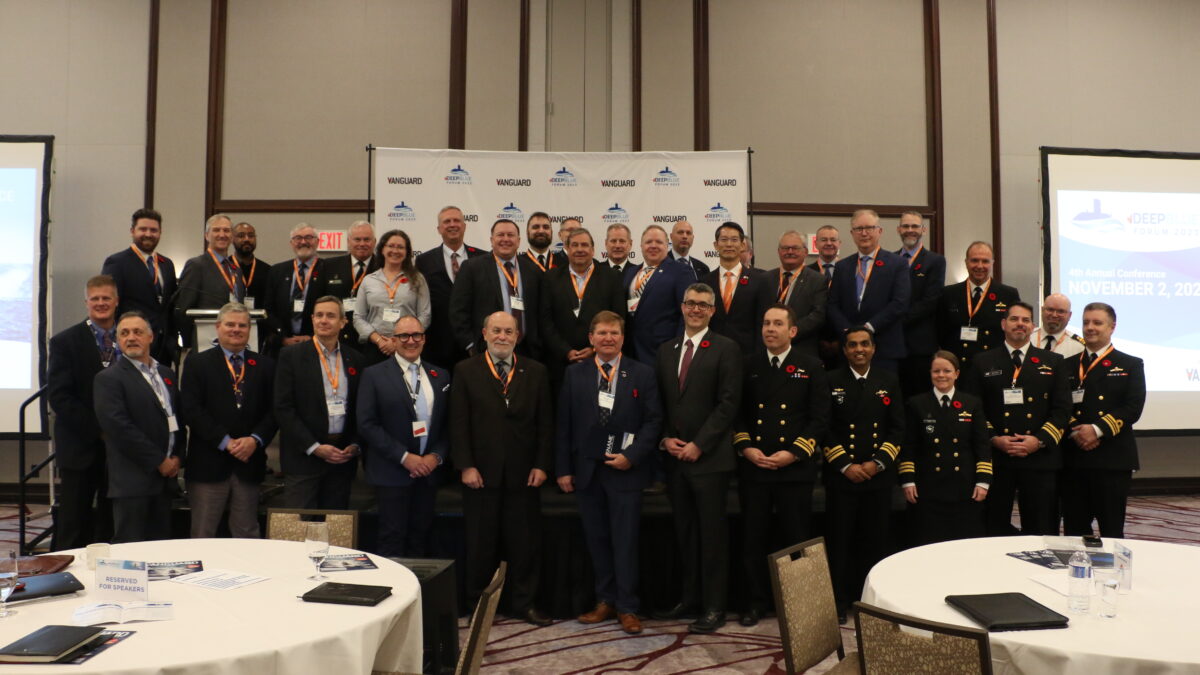Vanguard’s fourth annual underwater forum, Deep Blue 2023, was held in Ottawa on November 2, with a focus on the Canadian Patrol Submarine Project (CPSP) and submarine endurance. Like Deep Blue 2022, the day-long conference was conducted in person with simultaneous virtual streaming, engaging expertise from Australia, Germany, Sweden, the United Kingdom, and across Canada. More than 390 people spanning government and industry registered for Deep Blue 2023, 250 of whom attended in person and 73 participated virtually. The result was a dynamic interaction which was only limited by the time available.
The conference opened with a keynote speech by Commodore Jason Armstrong, the RCN Director-General Naval Force Development, on why a globally deployable conventional submarine was a necessary part of Canadian continental defence. He explained that, because the first Victoria-class submarine will leave service in 2034, followed by another one every two years, He underscored the Canadian Patrol Submarine Project, which is whole of Government initiative, not just DND, is open to talking with everyone in industry to expedite the procurement process. His speech highlighted the need for a submarine able to operate North of 60, including short forays under-ice, and the concurrent requirement for range, endurance, and persistence.
He was then followed by a panel discussion, moderated by retired Rear Admiral Casper Donovan, on the strategic perspective of why Canada needs an ocean-going submarine. The international panel explored future operating areas and the threat (if it can go to the Arctic then it can go to the European and Pacific theatres), people issues (notably habitability), the impact of climate change on operations, and environmental issues of how waste disposal impacts submarine design and endurance.
That was followed by a second panel discission moderated by Darcy Byrtus that posed a question to three submarine manufacturers: what drives design decisions in modern conventional submarines? Attendees then enjoyed three excellent presentations by SAAB/Kockums (with the C71 submarine), thyssenkrupp Marine Systems (with the Type 212 CD submarine) and Hanwha Ocean (with the KSS III – Jangbogo III submarine). Common themes soon emerged, including increased endurance (and the impact of human factors), stealth and the need to reduce all signatures (not just acoustic), power generation and storage, automation to reduce crew size and faster threat detection and classification capabilities.
Following a luncheon break, during which delegates had an opportunity to visit display booths, the afternoon keynote address was given by former Canadian Ambassador to the Peoples Republic of China, Guy Saint Jacques. He gave a powerful presentation on the threat posed by China and how it remains an important country for Canada. He underscored the need to implement the Indo-Pacific Strategy, spend more on defence, especially in the Arctic (and especially the Navy), diversify our trade, while working with Allies to develop common approaches.
The afternoon continued with a presentation by Tony March of Babcock Canada on submarine in-service support considerations in design. In discussing what constitutes design intent, he noted that standards alone are not enough. In addition to the concept of operations, there must be a concept of support that defines the operating cycle of the submarine – “adopt the certification programme to the design, not the design to the certification programme” and “minimize change to everything involved with the platform.”
The final panel discussion was moderated by retired Rear Admiral Luc Cassivi on waste disposal and management in a submarine, which discussed statutory conventions and whether or not navies had to adhere to them. Specifically, the IMO Polar Code is quite demanding, and if a submarine is to be fully compliant it will require modification to any Military-Off-The Shelf (MOTS) submarine design. The final event of the forum was a fireside chat on procurement considerations with CGAI’s David Perry and CFN’s Dave Hatherall, which discussed possible government procurement strategies, mechanisms to move forward quickly on a submarine procurement and the need to get down to a short list of potential bidders as soon as possible.
Summary
Deep Blue 2023 was a significant development from the previous three conferences where specific details of a future Canadian submarine, particularly those impacting endurance, were discussed in an open forum. Canadian submarine operations in the 21st century will demand a conventional submarine that, when it comes to endurance, has much more in common with a nuclear-powered-submarine than its 20th century predecessors. The need to be able to covertly transit and patrol, for many weeks and at enormous distances from supply and support must be the foundation of Canada’s future submarine.

